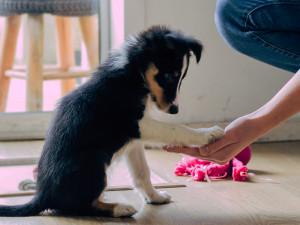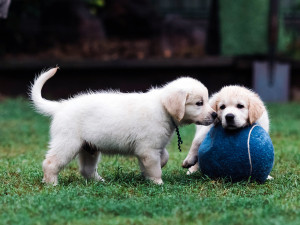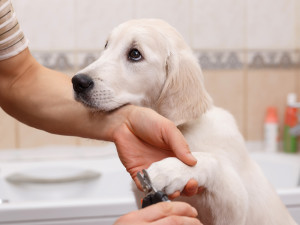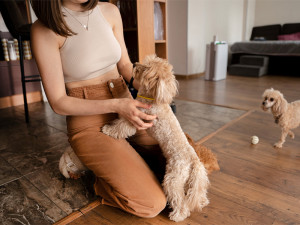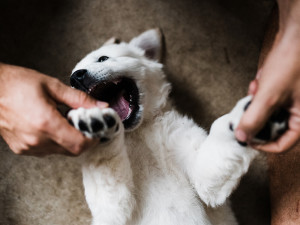Singleton Puppy Syndrome: One Puppy Litter
One doesn’t have to be the loneliest number when it comes to your dog

Share Article
In this article:
What are singleton puppies? Behaviour problems with singletons Raising singleton puppies One singleton puppy’s story
Singleton puppies are puppies born as the only puppy in their litter. There are complications that can occur, considered single puppy syndrome (also known as single pup syndrome), meaning there are challenges related to their normal development. Singleton puppies may face behavioural issues, including a lack of bite inhibition, trouble coping with frustration, sensitivity to touch and difficulties in social situations.
What are singleton puppies?
Have you ever met a dog named Solo, Uno or Only? It may not be just a cute name. The first question I consider asking is whether the dog was the only puppy in their litter. It’s rare, but dogs can give birth to just one pup – called a singleton puppy – and that can actually cause issues for the dog (and its human parents) down the road.
What’s the deal with one puppy litters?
For dogs, like many other species, early experiences are critical for normal social development. The time for true socialisation – during which puppies will learn lessons that directly affect lifelong behaviour – lasts from weeks 3–12. That’s why it is pretty well known that puppies have the best chance for normal social development if they are allowed to be with their littermates for 7–8 weeks at least; it’s not encouraged for puppies to be separated from their littermates before that.
In a typical litter of 3–12 puppies, there is constant physical contact. The puppies crawl all over each other, and they are used to the warmth, the contact, the interruptions and the movement that result from being in a pile of dogs. Unlike with Littermate Syndrome, the behaviour problems of singletons are a result of them being alone with little feedback and correction.
Can a dog have only one puppy?
The record for largest litter is 24 puppies, according to Guinness World Records. Having up to 12 puppies is not unusual, but the average litter size is 5–6 puppies. Although it’s far more common for dogs to give birth to a group of pups, having just one puppy is possible, and it does happen. A dog can have a one-puppy litter but have more puppies in her next litter.
How rare is single-puppy syndrome?
Single puppy litters are rare, though there’s no agreement about exactly how often it happens. People share information about big litters more often, presumably because they are proud of it and don’t often report smaller litters perhaps because they feel ashamed about it.
And not all puppies who are the only puppy in a litter face the associated behavioural challenges known as single puppy syndrome, especially because many people take steps to prevent it. So, single puppy syndrome is quite rare, affecting less than one percent of puppies.
What causes a singleton puppy?
There is no one reason that a dog gives birth to just a single puppy. Sometimes, there is a single puppy because only one puppy starts developing, perhaps because of poor nutrition or due to a mistimed mating in which there is almost no overlap in the time both eggs and sperm are present. Older mothers are more likely to produce singleton puppies, and that may be true for very young mothers, too. Sometimes there is a single pup because their would-be littermates don’t survive either in utero or the early days after birth. Small dogs have smaller litters, so they are more likely to give birth to a singleton puppy.
Behaviour problems with singletons
Littermates are a puppy’s first teachers, one of several reasons that it’s beneficial for puppies to stay with their litter for about two months. As the young dogs play, they use their mouths to tug or gnaw on their siblings’ ears, tails, paws and loose skin. If one puppy mouths another too hard, the puppy who got hurt will yelp, stop playing and move away.
This teaches puppies that hard bites, even if not intended to cause pain, result in an interruption in play. Singleton puppies and those taken from their litter before the age of five or six weeks often lack proper bite inhibition. Puppies need their littermates’ feedback to learn to control the pressure they exert with their mouths.
The problems that singleton puppies are prone to having are the result of not being raised in this traditional littermates-present environment. Common issues in dogs who were singleton puppies include:
poor bite inhibition
being unable to get out of trouble calmly and graciously
inability to diffuse social tension
trouble coping with frustration
not understanding social cues
lack of impulse control
touch sensitivity
What should you consider when training a singleton puppy?
Training a singleton puppy may require extra patience because these puppies are prone to becoming frustrated easily. With that in mind, keep sessions extra short and always start and end each session with an easy skill so the puppy is successful. Practice skills requiring impulse control such as “wait” and “stay” to help your singleton puppy strengthen their self-control.
Reinforce them for taking treats gently, and keep your hand open and flat with a treat in your palm when giving treats to help them learn to take treats nicely. Give them further practice using their mouth appropriately by playing fetch and tug and asking them to drop the toy as part of the game. Training a singleton puppy is much like training any other puppy, but they are more likely to need extra practice with some skills.
Raising a singleton puppy
If you find out that your dog is a singleton puppy early – anytime before the puppy heads to your home – there are things that can be done. Be sure to work on teaching bite inhibition, and handle the puppy a lot to avoid issues with touch sensitivity. Any gentle, regular handling is likely to help. Interrupt their feeding by pushing them gently off the mother so they must reattach to the nipple. This helps them get them used to life’s little frustrations. Have the puppy spend time with other puppies of the same age as much and as early as possible.
If at all possible, you may even consider raising the singleton puppy with another litter. Getting to spend a lot of time with another litter lets a singleton puppy have a more typical or normal experience as a young puppy. The adorable play between puppies, which is so enjoyable to watch, is anything but light-hearted frivolous behaviour – it provides puppies with the foundation for normal, healthy social behaviour as adults in many contexts and is a critical part of a puppy’s development and education.
Do singleton puppies have health issues?
The singleton puppy survival rate is not as high as for puppies born with littermates. One issue before birth is that a single puppy often doesn’t produce enough hormones to induce labour in the mother, so the pregnancy extends too long.
That can lead to a loss of oxygen and nutrients to the puppy, or it can lead to a puppy growing too big for a safe birth. Many veterinarians perform caesarian sections on dogs pregnant with a single puppy. Research about health problems after birth in puppies without littermates is sparse and there is not enough to say definitively whether there are patterns of health issues in singletons.
One singleton puppy’s story
A while ago, I met a two-year-old singleton Irish Water Spaniel. He was full of himself, had no frustration tolerance, little self-control and almost no impulse control. His issues with frustration and control led to lead aggression with other dogs. His pet parent, who had actually bred him, was able to turn his behaviour around, but it was a huge project.
The next litter from the same female was also a solo puppy who turned out fine and totally normal, except for being a bit large for the breed, which is not unusual for singleton puppies. The pet parent did everything right with her second singleton puppy: she raised her with a Lab litter that was only a few days different in age than the solo puppy, and did everything else I advised. She did end up spaying the breeding female after the second singleton as there was too high a risk of it happening again.
This second singleton puppy, benefiting from all the pet parent did to help her, was in no way behaviorally challenged like most singleton puppies are. The singleton turned out completely normal from a behavioural perspective, despite an unusual beginning, and this is an amazing accomplishment.
So, if you find yourself with a singleton pup, work on teaching bite inhibition early on, handle the puppy often to discourage touch sensitivity, help the puppy experience interruptions and frustration, and most importantly encourage the puppy to spend time with other puppies of the same age as much and as early as possible in those first 12 weeks.
Frequently asked questions
Is it normal for a dog to have one puppy?
It is unusual for a dog to have one puppy. Considering the challenges faced by singleton pups, it is fair to assume that having a litter of only a single puppy is not normal.
Are singleton puppies bigger?
Sometimes singleton puppies are bigger, probably because they get all the nutrition meant to be shared with other puppies. However, if health or nutrition deficiencies led to one puppy, they may not be bigger.
Should you adopt a singleton puppy?
Adopting a singleton puppy is a challenge and should only be considered by someone who is well aware of the potential difficulties and accepts that the puppy is less likely to develop into a dog with normal behaviour than dogs who had littermates.

Karen B. London, PhD, CAAB, CPDT-KA
Karen B. London, Ph.D., is a Certified Applied Animal Behaviorist and Certified Professional Dog Trainer who specializes in working with dogs with serious behavioral issues, including aggression, and has also trained other animals including cats, birds, snakes, and insects.
Related articles
![girl with blue hair starting puppy training with white dog]()
Puppy Training 101: How to Train a Puppy
You and your cute classmate have lots to learn
![The-Wildest_Editorial_Puppy-grooming-tips_Hero_1000x750_v01.jpg]()
Puppy Grooming 101: Tips For Grooming Your New Puppy
Professional dog groomer Jess Rona’s puppy grooming tips
![A woman sitting on a floor playing with her dogs.]()
10 Signs Your Dog Has Imprinted on You
This has nothing to do with a werewolf named Jacob in a series called Twilight, but here’s what it is all about
![Golden retriever puppy upside down playing with a mans hands and attempting to play bite.]()
How to Stop Puppy Biting: Training Your Puppy
Because bite marks are not a good look
![2 dogs playing]()
Does Your Dog Have Littermate Syndrome?
If you adopted puppy siblings – and they fight nonstop – you could be dealing with littermate syndrome. Here’s everything you need to know


